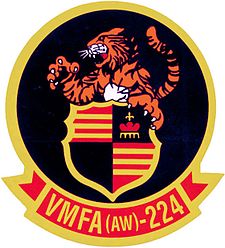VMFA(AW)-224
| Marine All Weather Fighter Attack Squadron 224 | |
|---|---|
 |
|
| Active | May 1, 1942 - present |
| Country | United States |
| Allegiance | United States of America |
| Branch | United States Marine Corps |
| Type | All Weather Fighter/Attack |
| Role |
Close air support Air interdiction Aerial reconnaissance |
| Part of |
Marine Aircraft Group 31 2nd Marine Aircraft Wing |
| Garrison/HQ | Marine Corps Air Station Beaufort |
| Nickname(s) | "Fighting Bengals" Fighting Wildcats (WWII) |
| Tail Code | WK |
| Engagements |
World War II * Battle of Guadalcanal * Battle of Okinawa Vietnam War Operation Desert Storm Operation Joint Endeavor Operation Iraqi Freedom |
| Commanders | |
| Commanding Officer | LtCol Michael Shand |
| Executive Officer | Maj Eric Geyer |
| Sergeant Major | SgtMaj M. E. Lambert II |
| Maintenance Chief | MSgt J. E. Rena, Jr |
| Aircraft flown | |
| Attack |
Douglas A4D Skyhawk Grumman A-6 Intruder |
| Fighter |
Grumman F4F Wildcat Vought F4U Corsair McDonnell F2H-2 Banshee Grumman F9F Panther McDonnell-Douglas F/A-18D Hornet |
Marine All Weather Fighter Attack Squadron 224 (VMFA(AW)-224) is a United States Marine Corps F/A-18 Hornet squadron. Also known as the "Fighting Bengals", the squadron is based at Marine Corps Air Station Beaufort, South Carolina and falls under the command of Marine Aircraft Group 31 (MAG-31) and the 2nd Marine Aircraft Wing (2nd MAW).
Attack and destroy surface targets, day or night, under the weather; conduct multi-sensor imagery reconnaissance; provide supporting arms coordination; and intercept and destroy enemy aircraft under all-weather conditions.
Marine Fighter Squadron 224 (VMF-224) was commissioned on May 1, 1942 at Naval Air Station Barbers Point, Hawaii. Flying Grumman F4F Wildcats, the Bengals entered World War II as part of the Cactus Air Force stationed on Henderson Field, Guadalcanal. Led by Medal of Honor recipient Maj Robert Galer, the squadron accounted for over sixty Japanese aircraft being destroyed in less than two months. The squadron also conducted close air support (CAS) missions while under constant attack from Japanese naval, air, and ground forces. VMF-224’s contributed significantly to the American victory during the Guadalcanal Campaign, which in turn, helped stem the tide of the Japanese advance across the Southern Pacific and secured a crucial foothold in the long island-hopping campaign against Japan.
...
Wikipedia
